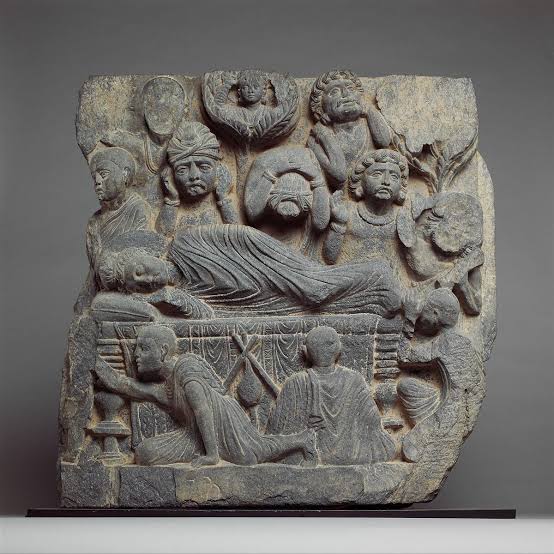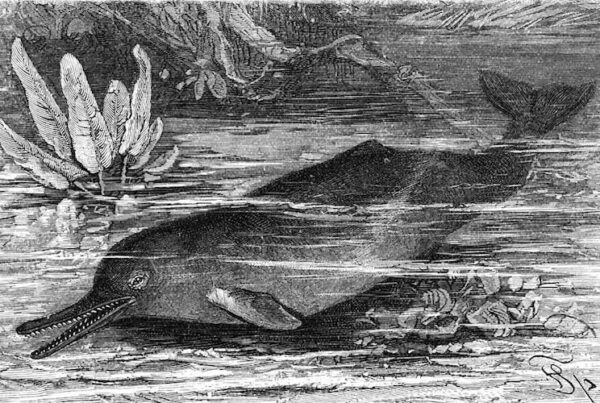First and second urbanization in the Indus Valley.
History is often written by conquerors. South Asia is no exception. South Asia also has a rich tradition native historiography often in form of folklore, oral narrative, genealogical record, inscriptions, and coins. Yet, there is another silent keeper of human population history: our DNA. Passed down from parents to children, it acts as a molecular timekeeper with the record of thousands of years of migration and settlement history, in form of accumulated changes to our DNA, overtime at a constant rate. But until quite recently, it was impossible to access and analyze this library of self. In the last decade, techniques were developed to successfully retrieve DNA from bones of ancient humans and analyze it.
Like looking through a microscope, this advancement in ancient DNA (aDNA) retrieval and analysis opened a flood gate of discoveries revealing the identities of ancient farmers from the Near East that ushered a revolution in large scale domestication of crops and animals. Farmers of the Near East BCE represented three distinct populations from Anatolia, Levant and the Zagros mountains of Iran. Dated between 9th and 7th millennium, these three groups were as distinct genetically from each other as Europeans from East Asians[1].
Farming moved east to Central Asia and South Asia around 7th millennium BCE. However, it wasn’t clear whether the Near Eastern farmers genetically contributed to the ancestry of Indus Valley population. In the coming years, focus of Dr. David Reich at Harvard University, turned to South and Central Asia. Using aDNA from more than 500 individuals from Europe, West, Central and South Asia, the team of untangled genetic history of South Asia from the dawn Indus Valley Civilization to the culmination of classical Gandhara with the arrival of the Ghaznavids.
1) South Asian Bronze Age: Indus Valley Civilization
Among a large set of genetically identical individuals buried in the necropolis of Gonur Tepe in present day Turkmenistan and Shahr-i-Sokhta in far southeastern Iran, a set of genetic outlier individuals were identified. The individuals carried a yet unsampled ancestry, not related to any modern individual outside south Asia to date, yet distantly related to hunter gatherers of the Andaman Islands and peninsular South India. It was postulated to belong to an extinct South Asian hunter gatherer population termed Ancient Ancestral South Indian AASI. These outlier individuals hereby termed Indus Periphery also caried ancestry derived largely from farmers of the greater Iranian plateau. Based on their burial context, these were likely migrants from the Indus Valley Civilization (IVC) and nearby bronze age cultures of Afghanistan and Baluchistan. This was confirmed when aDNA was analyzed from a woman buried at an IVC site in Haryana. She carried similar ancestry related to farmers of ancient Iran and hunter gatherers of South Asia[2, 3].
2) Gandhara Iron Age:
Although, these ancient individuals formed majority of the ancestry of modern-day South Asians, it was not enough to explain all the ancestry related to west Eurasian populations in South Asia (Figure 1).After the collapse of the IVC, a phase of second urbanization was documented in Gandhara named Gandhara Grave Culture or Proto-Historic Grave based on the region and unique burial tradition associated with that culture (Figure 4) [4]. Individuals from Swat and Chitral belonging to this cultural context were sequenced for aDNA and analyzed at Harvard. Two outliers among these Iron Age individuals of Swat, carried 25% to 40% of ancestry related to bronze age pastoralist population of steppe lands of Europe and Central Asia termed Steppe_MLBA; among these sites is Sintashta known for elaborate burials of spoked wheel chariots and parallels with the culture described in the Rig Veda. Furthermore, several individuals carried haplogroups (a marker of direct paternal or maternal descent) not previously found in Indus Valley outliers but present in large numbers in modern populations of South Asia such as paternal haplogroup R1a and maternal haplogroup H. Great majority of Iron Age individuals from Swat however, carried Steppe_MLBA related ancestry from this type of population likely migrating over the Hindu Kush mountains in late bronze age (Figure 2A).
In conclusion, introduction of farming and associated sedentary lifestyle was one of the key changes in the genetic history of South Asia including Gandhara. By late bronze age, in need of better pasturelands, nomadic pastoralist tribes moved across the Hindu Kush highlands into what is now Pakistan, from the climate change ravaged Central Asia. They brought with them not only unique customs such as cremation and Ashvamedha (horse sacrifice), but likely also early dialects of a language later codified as Sanskit in Gandhara by Panini in 6th century BCE.
Historic Buddhist Gandhara and its eventual decline:
3) Historic Gandharan cosmopolitan culture:
Establishment of Buddhism had a major impact on the culture and society of ancient Gandhara. Situated on the crossroads of Central, West and South Asian heartland, herein blossomed centers of cross continental commerce, Greco-Buddhist art and monumental architecture in forms of stupas and monastic complexes most notably at Taxila and Swat. Analysis of the aDNA retrieved from individuals buried in the monastery complex at Saidu Sharif and contemporary historic settlements at Aligrama and Butkara, shows that these individuals drift away from the cluster formed by the earlier Iron Age populations of Swat (Figure 1). The burial traditions of these historic era individuals, dated between 400 BC to the start of the common era, are not similar to the previous proto-historic individuals, rather they show similarities with burials at the 2nd to 3rd century BC Sarai Khola at Taxila. It’s likely Buddhism practiced by this so called, “immigrant monk,” from ‘Greater Gandhara’ coexisted alongside myriad of local beliefs and cult practices[5]. There wasn’t however a large-scale migration to Swat valley since multiple individuals from Barikot citadel from Saka and Indo-Parthian time period to medieval Khilji Sultanate period carried ancestry identical to the previous Iron Age population of Swat. Two outlier individuals buried at Saidu Sharif monastery further point to the cosmopolitan nature of Buddhist Gandhara:
1) A 40-year-old male labeled Saidu_Sharif_H_o1, that carries majority of its ancestry related to Telugu speakers of South India, is likely a migrant to Swat from South India.
2) A woman in her 30s labeled Saidu_Sharif_H_o2, carries roughly 20% of her ancestry related to Greek colonists of Iberia. She is likely a descendent of European population that arrived in the region with the conquest of Alexander of Macedon and continued to rule in Gandhara and Punjab until after the common era.
Gandharan monks traveling along the silk road have been well documented as the propagators of Buddhism in China, Japan and Korea. Later on, these monks also introduced Buddhism to Tibet, with common folklore associating Guru Padmasambhava to have belonged to Uddiyana an ancient name of Swat. Interestingly, one individual buried in Xinjiang during this time is almost identical to iron age population of Swat (Figure 2B).
4) Late Historic and Medieval Gandhara:
End of Kushan rule, followed by Hephthalite invasion led to a period of gradual decline of Buddhism in Gandhara. In the 7th century CE, when a Chinese monk Xuanzhang visited Gandhara, he noted the dilapidated condition of several monastic complexes and a presence of heretic deva temples. Monumental temple complexes belonging to the Vaishnavism and Shaivism have been attested in the archeological record from this time period until the end of Hindu Shahi rule in Gandhara in the 11th century CE[6]. In 1002 CE, following the defeat of the Hindu Shahi King Jayapaladeva, Mahmud of Ghazna took control of the Vale of Peshawar. While Hindu Shahis lost Swat soon after, local Hindu chieftains likely kept on ruling under suzerainty of Muslim rulers in Swat. A Tibetan monk visiting Swat in 13th century mentions local Hindu chiefdoms governing Nagarkot (Kangra), Malot (Salt Range) and Manglore (Swat)[7].
Four individuals were sequenced for aDNA from the medieval time period in Swat (11th century to 13th century CE). Three of these individuals from the Muslim phase of Raja Gira fort settlement and Udigram Mosque, represent a non-native population likely originating in what is now Afghanistan, this nascent Muslim community was buried in their own small graveyard with one of the first mosques in northern Pakistan made for a small size of congregants. However, one medieval era women buried in Barikot citadel is not different genetically from the Iron age population of Swat and is proximal genetically to local Kohistani population of Swat (Figure 2A).
5) Contemporary Gandhara:
Among the present-day populations of Gandhara, Swat Kohistani speakers show the highest proximity genetically to the Iron Age and historic/medieval population of Swat in ancient DNA record (Figure 3B). Most population groups from contemporary Gandhara have two streams of ancestry, one from Swat Iron Age SPGT and historic individuals from Saidu Sharif and Barikot. Medieval individuals sampled from Parwak and Singoor for aDNA work as the best source of ancestry for present day Chitral population groups. These two individuals derive most of their ancestry from iron age population of Swat SPGT, and two SPGT outliers with an additional ancestry from steppe pastoralists (Figure 3A). Lastly, minor ancestry related to the expanding Tibetan empire and Turkic empires in the medieval period can be traced in contemporary populations of Khyber Pakhtunkhwa, Gilgit Baltistan, Jammu and Kashmir and parts of Punjab[8].
In conclusion, genetic proximity of contemporary Swat Kohistanis to Iron Age Swat individuals suggests that Gandhari Prakrit and closely related Dardic languages were once widely spoken in Gandhara. Iron Age and historic Buddhist era individuals buried in Swat, nonetheless, constitute a major ancestral stream of contemporary populations of Gandhara. Numerous imperial powers asserted their rule on what constitutes Gandhara today, however, population of Gandhara remained relatively stable until the medieval Ghaznavid period.
Written by Shahzad Hasan
Reference:
1. Lazaridis, I., et al., Genomic insights into the origin of farming in the ancient Near East. Nature, 2016. 536(7617): p. 419-24.
2. Narasimhan, V.M., et al., The formation of human populations in South and Central Asia.Science, 2019. 365(6457).
3. Shinde, V., et al., An Ancient Harappan Genome Lacks Ancestry from Steppe Pastoralists or Iranian Farmers. Cell, 2019. 179(3): p. 729-735 e10.
4. Zahir, M., Gandhara Grave Culture and Pakistani Archaeologists: The Pitfalls and Challenges of Traditional Archaeology. 2021.
5. Olivieri, L.M., The early-historic funerary monuments of Butkara IV. New evidence on a forgotten excavation in outer Gandhara. Rivista degli Studi Orientali, 2019. 92.
6. Olivieri, L.M., Temples of Swat. The Shahi archaeological landscape. Royal Asiatic Society Of Great Britain and Ireland, 2021.
7. Tucci, G., Travels of Tibetan Pilgrims in the Swat Valley. The Greater India Society Calcutta, 1940.
8. Yang, X.-Y., et al., Tracing the Genetic Legacy of the Tibetan Empire in the Balti. Molecular Biology and Evolution, 2021. 38(4): p. 1529-1536.




